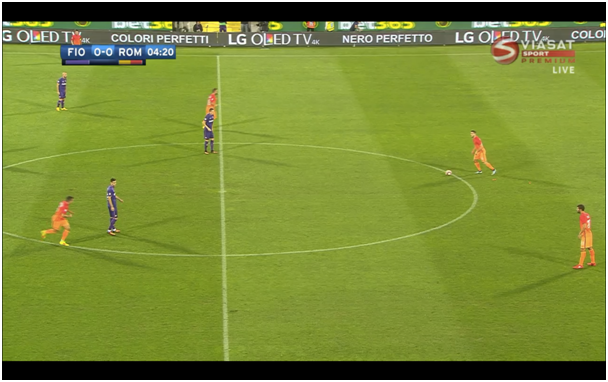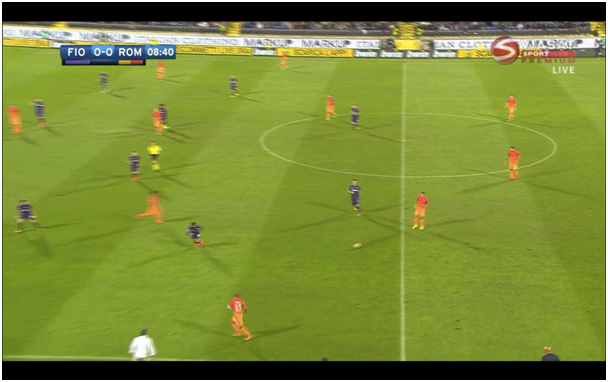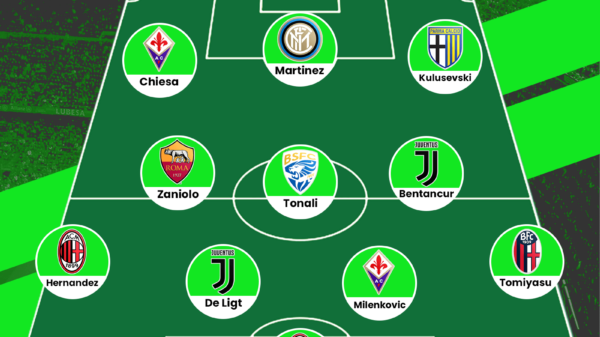William Bergendahl writes a detailed tactical analysis about the match that ended Fiorentina 1-0 Roma.
Fiorentina hosted Roma in a game of few chances. Roma controlled the ball for the majority of the first half with Fiorentina taking control for most of the second. Both teams defended impressively in highly compact structures leaving little space to attack. Badelj managed to score late in the second half trough a shot from distance to secure the three points for the Florence side.
Line Ups:

Made using TacticalPad
Fiorentina: Tatarusanu- Tomovic, Gonzalo, Astori, Milic- Badelj, Sanchez- Valero, Ilici, Tello- Kalinic
Roma: Szczensny- Florenzi, Manolas, Fazio, Peres- De Rossi, Strootman- Salah, Naigolan, Perotti- Dzeko
Roma’s attacking structure was based around a 4-2-3-1 which was transformed into more of an asymmetric 3-1-4-2 with Strootman dropping to the left of the centre-halfs to create a 3-man chain out of defence. Perotti moved centrally between lines occupying mainly the left halfspace while Salah played higher and wider trying to isolate his defender in a favoured 1v1 situation. In response Fiorentina defended in a 4-4-2-0 formation with zonal-orientation to create compactness and remain control of central areas of the pitch.
Fiorentina attacked in a 4-2-3-1 formation with Tello, Ilicic and Valero playing narrow just behind Kalinic while the ball-near fullback pushed up to create space horizontally when establishing play in Roma’s half. The structure was for most parts of the game massively disconnected with the platform of 6 players playing far from the 3 players trying to move between lines, this made it almost impossible for Fiorentina to access the 10-space when building play from deeper areas. Roma defended in a 4-2-3-1 formation which could sometimes be interpreted as a 4-3-1-2 with Naigolan playing the same line as Strootman and De Rossi to compensate for Salah who positioned himself for a counterattack.
Fiorentina’s impressive defensive display
Fiorentinas basic structure in defence was a 4-4-2-0/ 4-2-2-2, there where zonal-orientations to remain compact with some players tasked with closer man-orientations, most clearly in the first line.


As seen in the above pictures the first line of Fiorentinas defence oriented themselves around the positions of Roma’s double-pivot of Strootman and De Rossi. They would only leave their players to press the centre-halves if they took the ball forward to threaten the Fiorentina block, thus forming a 4-4-2-0 formation off the ball. The block would be oriented around the halfway line making it a medium block.

Roma tried to create a problem for Fiorentina via a 3 man-chain in the first line with Strootman dropping to the left of Fazio. This was done to get access to the left halfspace which Perotti occupied while Perez pushed up from left-back. Fiorentina handled the situation through Tello’s zonal-orientation designed to protect the halfspace and maintain control of central areas of the pitch. As you can see the play was forced wide where Tomovic at right-back could press after leaving Perotti to the cover-shadow of Tello.

A key component of Fiorentina’s defensive display was, as mentioned earlier, their highly compact shape. This allowed them to remain in control of vital areas of the field making it almost impossible for Roma to play within the block, forcing play back to the centre-halves making the Roma circulation into a U-Shape.

Fiorentina also had a few ideas on how to win the ball through a number of pressing-traps higher up the pitch. They were built around a combination of cover-shadows and a man-oriented structure leaving one Roma player with just enough time and space to be an attractive option only for him to be pressed aggressively upon receiving the ball. In the above example you can see Fazio as the intentional free man while Ilicic plays close to Strootman, when the ball is played he leaves his marker with Badelj moving up to mark Strootman. The far side of the pitch is underloaded by Fiorentina but since they as man-oriented in this situation they have good access to press meaning Roma are unable to find the weaker side.

The same principles can be seen in this image with Manolas being the free man only to be pressed when the ball is played to him. Fiorentina again making clever use of covershadows and man-orientations while underloading the far side to make Roma play in areas they have good defensive access to.

Fiorentina changed their defensive system a bit in the second half with more emphasis being placed on winning the ball. This was done through an even more central orientation of the wingers, creating more of a 4-2-2-2 system. This made Kalinic and Ilicic able to press Roma’s central defenders without the risk of giving up central control. When the ball was played to the open wing-area you could see the far side winger moving into the 6-space to mark Strootman/De Rossi while the nearside winger would press the fullback on the ball. This was rather effective in forcing Roma into going long into areas where Fiorentina could win the ball back and restart play.

When the ball reached wing-areas Fiorentina made sure to keep a numerical superiority at the heart of defence by letting the far side fullback come in while at least one of the central midfielders protected the secondball-area.
Roma’s attacking structure
As mentioned earlier Roma’s attacking shape could be described as an asymmetrical 3-1-4-2, the structure looked quite good at this but Roma still had problems breaking down Fiorentina’s compact defence.

The image above shows Roma in a 3-1-4-2 with Strootman playing at the left of a 3-chain while De Rossi was creating the connections from the backline to the players behind the compact Fiorentina line (Naigonlan and Perotti for most of the time). As mentioned earlier Roma had some problems penetrating the Fiorentina block despite some good positional play. I think they could have benefitted from moving the ball quicker in the first line, perhaps moving the ball into wing-areas to open up the halfspaces in which they had some good positioning at times.

If the suggested moves were to work however they would have needed De Rossi to be a bit more ball-oriented at times to have support when playing the ball into the halfspace from the wing, a more ball-oriented position of De Rossi would also allow Perotti to position himself behind Fioentina’s midfield line due to the support of De Rossi. The type of ball circulation and positional play suggested above would at least have helped Roma to unbalance the Fiorentina defensive block and possible create usable space in central areas or the far side halfspace to attack.
Conclusion
In a game of many interesting tactical concepts on display Fiorentina managed to get the win through a long range effort from Badelj. Both teams showed an impressive level of compactness in defence making it hard for whoever had the ball to break lines, especially in central areas of the pitch. A scoreless draw would probably have reflected better on a night of few clear chances.
Read all our Tactical Analyses here.
- Tactical Analysis: Fiorentina 1-0 Roma | Home side win through defensive control - September 23, 2016
- Tactical Analysis: Eibar 1-1 Sevilla | Sampaoli´s Sevilla struggle against Eibar - September 20, 2016

























































